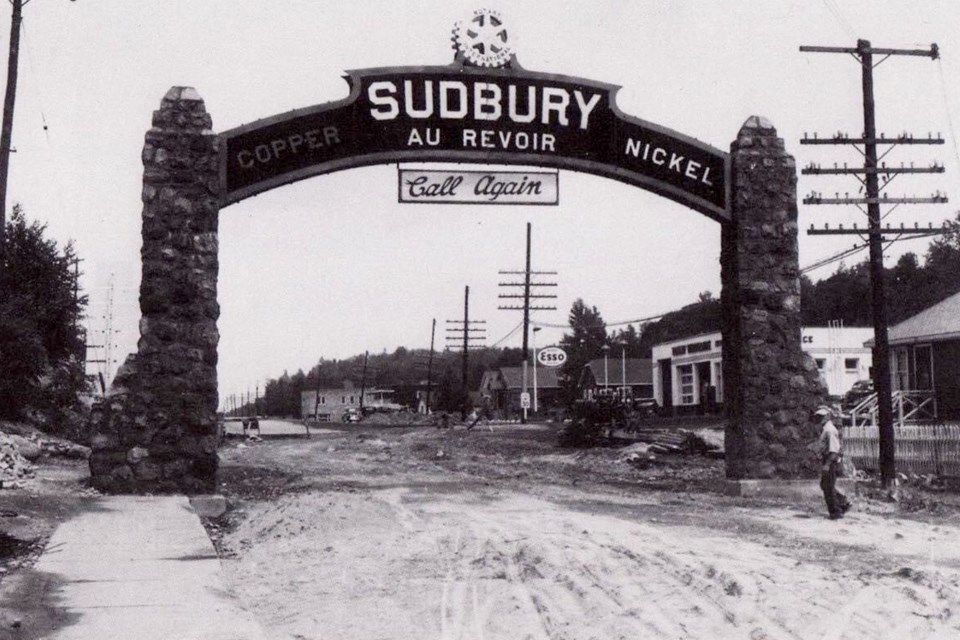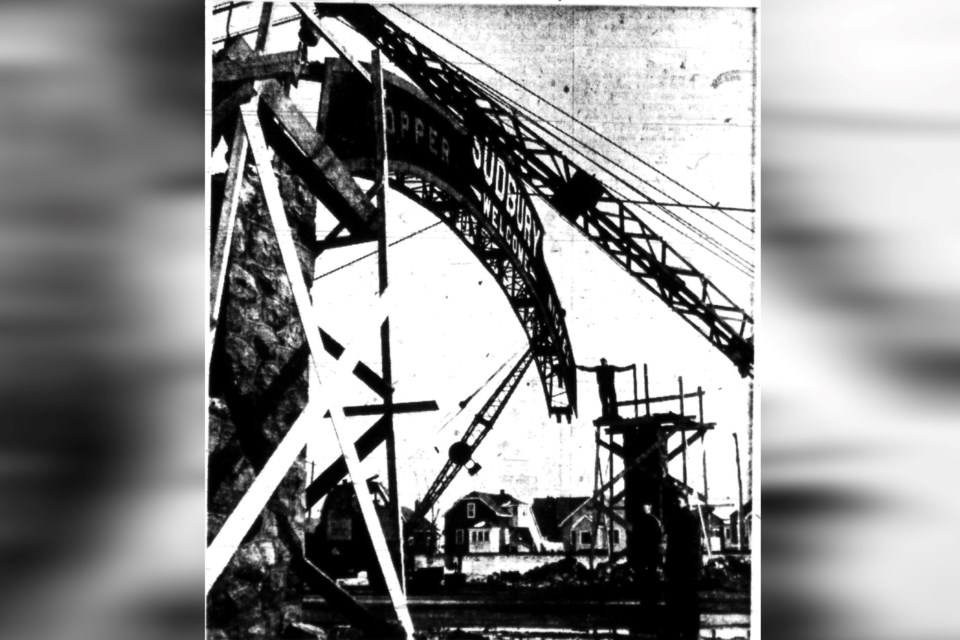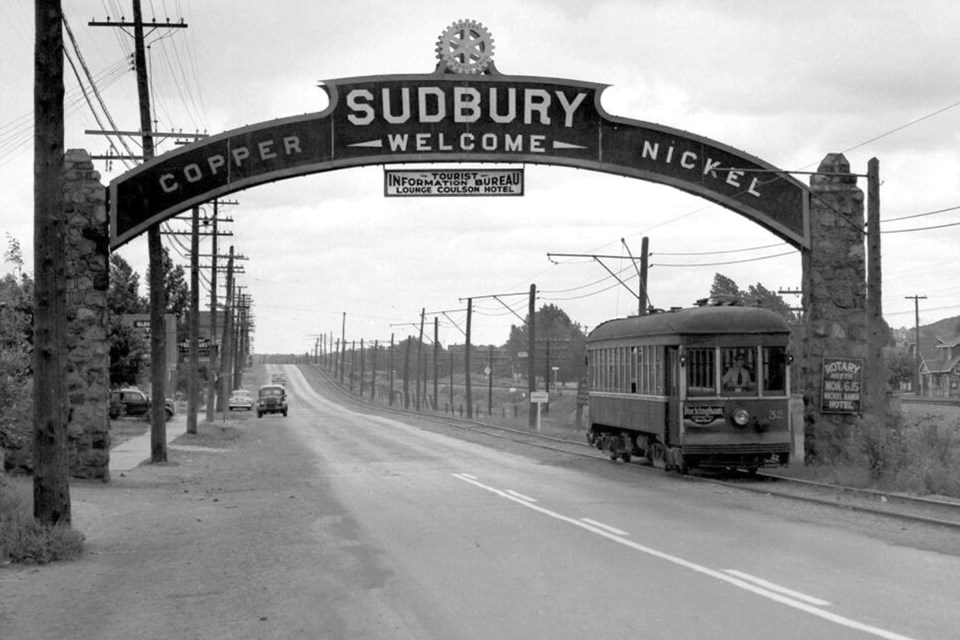Even though their lifespan amounted to a little more than 15 years, these two monolithic bipedal creatures have been the talk within Sudbury historical circles for many years.
They stood at opposite ends of what was then the nascent city of Sudbury (it had just reached city status in 1930), welcoming tourists and residents of nearby communities alike. Now, you might be asking yourself to what I am referring.
In this first column in a new Then & Now historical series, I would like to take you on a trip to the past to look at the short history of the Sudbury Welcome Arches.
If you were travelling towards Downtown Sudbury from the eastern or western outskirts of the city, one would be hard-pressed to believe that arches once existed spanning each roadway. The eastern Welcome Arch was located on The Kingsway, just to the west of where Laking Toyota stands today. Its sibling, the western Welcome Arch, was situated on Lorne Street, at a spot approximately mid-way between Byng Street and Martindale Road.

Traditionally, city gates were built to provide a point of controlled access to enter and depart a walled city for the people and their vehicles (and animals). The city gate was also commonly used to display a diverse kind of public information such as announcements and schedules. It would also be ornamented with heraldic shields, sculptures or inscriptions.
Harkening back to the arch builders of yore, the local Rotarians (most likely during the waning days of their 10th Anniversary celebrations in 1934) planned to build two welcome arches at either entry point to the city. The arches were to be built at the (then) city limits on the Coniston Road (not long before it was renamed The Kingsway) and the Copper Cliff Road (later to be renamed Lorne Street).
The Rotary Club of Sudbury took pains to stress that not a single nickel of the money contributed by the public to Rotary’s community work would be used to create these gifts to the city and its residents. The Rotarians would in fact be “digging into their own pockets to see to it that the city's entrance gates are completed in a manner that will be a credit to Sudbury.”
The task of designing and building the initial structure, which would comprise pillars made from fieldstone, had been left by the Rotarians in the very capable hands of stonemason Annibale “Andy” Rebellato.
Unfortunately, a quick completion was not to be and in July 1935, the local Rotarians were forced to announce their commitment to finish the still uncompleted arches. The gates to the city had stood half-assembled for a short time (How long? We may never know based on the historical record).
In their own words, they were “holding themselves personally responsible for (the) completion of the entrance gates.” The Rotarians “came to the front and said they would see to it that the job was properly finished.” From the wording which they presented at the time, clearly, the ball had been dropped on this project and it was time to pick it up and move it forward to completion.
Work on the arches that would span the already erected fieldstone pillars was re-commenced immediately upon the receipt of materials contracted from the Dennis Ironworks of London, Ont.
In order to create a design for which the citizens could be proud of, the architectural staff of the International Nickel Company was enlisted to design both of them. On the “outside” of each gate the words “Sudbury” and “Welcome” could be seen in big bold letters greeting everyone as they pass through and into the city.
Those words are book-ended with the names of the two major products for which the city (and the company which assisted in the arches designs) was known. On the left, the word “Copper” can be seen and on the right is the word “Nickel”.
As a special flourish that may not have been recognized by most passersby, those very words were produced in the specific metal known by that name. The border of the arch was plated in copper and nickel as well, while the previously built pillars, in a nod to the surrounding landscape of the Cambrian Shield, had been made of rough-hewn fieldstone.
On the “inside” of each gate, the Rotarians decided to replace the word “Welcome” with “Au revoir”, a nod to the other main founding language group of the city of Sudbury. The arches were then topped with the “heraldic shield” of Rotarians worldwide, the emblem of Rotary International, consisting of six spokes and 24 cogs, giving it a sturdy appearance, and reflecting a real, working gearwheel.
By mid-September 1935, the welcome arches were completed and greeting their first guests to the Mining Capital of the World. When all was said and done, local Rotarians had spent in excess of $13,000 of their own money (nearly $286,000 in 2024) to have both of the arches erected. Rotarians had supplied all of the materials necessary except for the stone for the pillars, which was provided by the Department of Highways. The construction, itself, was undertaken by city workmen.
At a certain point during the lifespan of the arches, a couple of additions were made to serve the public information aspect of the arch’s duties. On entering the city from either the east or the west, a sign could be seen on the right pillar announcing that “Rotary meets Mon. 6:15” at that venerable (and also now long-gone) Sudbury hotel landmark, The Nickel Range Hotel.
Also, below the centre of the arch, hovering over the streetscape, was another sign directing visitors to the “Tourist Information Bureau” (oddly enough) in the lounge at the Coulson Hotel. This sign was backed with the words “Call Again” to remind visitors that they will always be welcome to return.
Unfortunately, the lifespan of these beautiful arches was doomed to be short (yet memorable). In July 1950, Sudbury's public works department removed the eastern arch to allow for road widening on the Kingsway. The road was being upgraded from a 30-foot strip of pavement to a 38-foot cement road surface.

At that time, the Rotary Club protested strongly to council about the removal of the eastern arch about which they were left in the dark (literally until the day it was spotted being dismantled). Even though, as the motion at city council authorizing its removal specifically states, the Rotary Club had to be informed prior to the commencement of work. However, they were assured by then mayor, W. S. Beaton, in what turned out to be a quick act of placation, that the arch would be replaced when all roadwork was completed.
Two months later in “honour” of the 15th anniversary of both arches, their necessity and value was brought up for debate at a meeting of Sudbury city council.
Both sides of the argument were on display at the meeting. A local resident presented a letter to council, arguing that the recently dismantled Kingsway arch should remain down “as such things were not approved by modern planning experts.” He also “felt demolition of the arch had served to improve the eastern entrance to the city.”
However, the arch’s most fervent proponent, Alderman E. A. Whissell, was of the opinion that “the arch had been the subject of tourist photos (for many years) and as such had brought widespread publicity to Sudbury.” He declared in council chambers that “the arch was the most outstanding of its kind in Northern Ontario," and that "it was a great advertisement for the city."
At this time, council chose to forward the resident’s letter on to the Rotary Club along with a request to the members as to whether they would consider building a new one at the eastern entrance of the city (pending engineering approval, of course).
In December, acting on a request from the Central Co-coordinating Committee of Sudbury Service Clubs, council instructed city engineer W. B. McMullen to obtain costs and bring in a report as soon as possible on replacing the eastern arch. Mayor Beaton again stressed to the Rotary Club that the arch would be replaced.
Regrettably, the September council meeting also sounded the death knell for the west-end arch as well. W. B. McMullen announced to council at that time the provincial government’s consideration of a plan for “widening the roadway at the west end of the city which would necessitate removing an identical arch there.”
This came to a head in late February, 1952, when the sole remaining city arch, spanning the Copper Cliff Road, which had been welcoming motorists to the city for the previous 17 years, was removed by the Department of Highways in order to allow for a new 40-foot, four lane road surface.
Unfortunately, just as with its east-end sibling, the Rotarians of Sudbury were once again left in the dark about the demolition of their project. This time, they only became aware of its fate when a member observed the workmen on site preparing for its removal.
The Ontario Department of Highways divisional engineer William S. Cole said at the time that “the department does not contemplate replacing the western arch.” He emphatically declared that “it was a traffic hazard which he does not intend to see re-erected.”
The Rotary president at the time, Edward Lafrance, stated that the club (clearly unhappy about this repeat of the previous turn of events) would look into finding out how the removal of the western arch came about and under whose authority.
As he continued, “Older members of the club … feel somewhat put out at the way things have worked out, since many of them contributed considerable sums towards financing erection of the arches and took pride in the many comments the spans drew from tourists and others passing through the city.”
Over the years, no formal mention of what became of any of the parts of either structure after their removal has ever been confirmed. Although in 1966, the eastern arch “poked its nose” back into the public eye before being wiped out in one fell swoop. A construction crew working on a storm sewer and water line project on the Kingsway ran into the concrete base of the old arch (ten feet below ground, no less), promptly blasted it to pieces and hauled it away.
However, if one were to be travelling on The Kingsway today, the first house to the west of Laking Toyota has a three-sided front yard border made up of stones that look suspiciously like those that comprised the former Kingsway arch which would have been near that very spot (if anyone knows for sure, please let me know).
In the end, the much-needed improvements of road conditions for drivers in our ever-expanding city of Sudbury lead to this severe case of fallen arches at the outskirts of the city and the loss of two monumental early tourist attractions.
Jason Marcon is a writer and history enthusiast in Greater Sudbury. He runs the Coniston Historical Group and the Sudbury Then and Now Facebook page. Then & Now is made possible by our Community Leaders Program.
